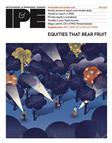Japan appears to be in a vicious circle right now, with low interest rates, a banking industry burdened by bad loans and moribund financial markets all weighing on the world’s second largest economy. And that’s not to mention a rapidly ageing population.
To try to dig its way out of the hole, the government is going for “structural reform with nothing sacred”. There can be “no growth without reform” it says. And it has named a hard-line reformer – Heizo Takenaka – as financial services minister.
The government has also set out a series of tax reforms – totalling around ¥1.8trn (E138bn) in fiscal 2003.
There’s no denying the seriousness of the situation. The benchmark Nikkei 225 stock index has just come off its worst ever year. It lost 19% of its value in 2002 and ended the year at its weakest year-end close for 20 years.
By any measure, the economy is suffering. A survey of economists found that gross domestic product is likely to have fallen 0.4% in the fourth quarter. Japanese consumers are spending less and unemployment is on the rise at 5.5%.
The banks, burdened with $333bn of bad loans, are continuing to suffer. Lending by Japanese banks fell 4.7% in January, compared to a year earlier. This has hit their ability to lend, even to healthy companies.
Bank of Japan board member Shin Nakahara said in a speech recently: “Structural problems and the presence of non-performing loans complicate the problems associated with deflation, causing them to become more entrenched and to affect a broader area of the economy.”
Nakahara says the challenge for Japan’s economy is to achieve two contradictory objectives. It has to advance “structural adjustment” and the disposal of non-performing loans. Yet at the same time it must minimise the deflationary impact of such actions and return the economy towards self-sustained recovery.
None of these problems are eased by a high savings rate and an ageing, dwindling population. Japan has always had a high savings rate – it is currently running at 10%, ten times that of the US. And with the ageing of Japan’s population, the country’s citizens are not about to change the savings habits of a lifetime.
Japan’s citizens have the world’s longest lifespans and the government is now projecting that the population will start to decline in three years. By 2007, the proportion of the population over 65 will have risen from 10% to 20% since 1986. Older citizens save for their retirements and keep their spending to a minimum. There is evidence that this scenario may be starting to take effect. Consumer spending, which accounts for 55% of the economy, fell 0.7% in the most recent quarter.
But the Bank of Japan disagrees that there’s a problem. It says: “Japan’s savings are not too high for the purpose of maximising long-term economic growth”. If anything, it says in a research paper, certain data imply that the savings rate “is likely to decline, and, consequently, the investment-savings gap ratio over GDP may start to diminish in the near future”.
“The ageing society is not only a matter for the future, but a matter of the present,” says the Japan Centre for Economic Research (JCER).
The ageing of the population is set to be accompanied by a decline in the number of productive workers. Tatsuya Ishikawa of the economic research group at NLI Research says: “According to our calculations, the number of employed persons will decline from 64.13m persons in 2001 to 43.89m in 2050, or 32%. The average annual rate over the period is –0.8%.”
Elsewhere, the economy has seen some bright spots. Exports are still holding up. They rose by almost 16% in December. For 2002 as a whole they were up over 6%.
But any recovery might be nipped in the bud by events outside Japan. “Given that a new and supposedly radical team has recently been appointed by the prime minister, 2003 starts with some elements of hope,” says asset management firm Border Asset Management in a research note. But it says the background in terms of global outlook is not helpful and Tokyo “may well be daunted by the prospect of changing course in a becalmed world”.
“The outlook for 2003 is probably more of the same - two paces forward, one back, two paces back, and one forward,” Border says. “Tokyo only offers a prospect of modified rapture for 2003.”
As State Street Global Advisors’ head of quantitative developed markets Michael Schoeck says: “Anyone looking to Europe and Japan as motors of a global economic recovery will be sorely disappointed.” He adds: “Japan will probably have the third growthless year in a row.”
For its part, the JCER sees the short-term outlook characterised by “lethargic growth”. This would be due to the continuing weakness in the corporate sector and worsening job conditions as the cleanup of bad loans takes place.
The banks and brokerages themselves have mixed views on the outlook for Japan. Mizuho Securities says, “2003 is a year in which one must be prepared for a long-term prescription, continuation of low interest rates and the risk of an extreme hump”. The Daiwa Research Institute says it thinks the economy has bottomed, though “the pace of recovery is exceedingly moderate”.
That may be looking on the bright side for now, but it remains to be seen how Japan’s changing demographics and an unstable geo-political outlook will affect the country’s economy, financial markets and society over the next few years.














No comments yet